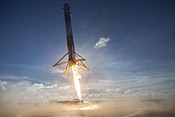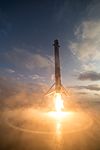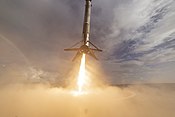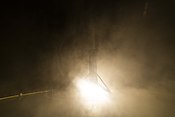无人驾驶着陆船
来自维基百科,自由的百科全书
自主太空坞无人船(英文:Autonomous spaceport drone ship,简称:ASDS)是从甲板驳船衍生的远洋船,配备了位置保持轮机和大型著陆平台,并由自主机器人控制。 航天公司SpaceX委托建造这种船只,以便在海上回收火箭的第一级推进器,以执行运载火箭升至轨道或行星际轨道后载运的燃料不足以返回发射场的任务。
| 名称 |
|
|---|---|
| 地点 |
|
| 简称 | ASDS |
| 所属 | SpaceX |
| 发射台数 | 4个远洋登陆平台(2个活跃; 1个正在生产; 1个已退役) |
| “请阅读说明书”号 (I)着陆历史 | |
| 状态 | 服役 |
| 着陆 | 107 (105次成功, 2次失败) |
| 首次着陆 | 2015年1月10日 (CRS-5) |
| 末次着陆 | 2015年4月14日 (CRS-6) |
| 相关火箭 | |
| “当然我依然爱你”号着陆历史 | |
| 状态 | 服役 |
| 着陆 | 130(123次成功, 7次失败) |
| 首次着陆 | 2016年3月4日 (SES-9) |
| 末次着陆 | 2021年5月4日 (Starlink 25) |
| 相关火箭 | |
| “缺乏庄严肃穆”号着陆历史 | |
| 状态 | 服役 |
| 首次着陆 | 2021年8月29日 (CRS-23) |
SpaceX有两艘可操作的无人船。 “请阅读说明书”号(Just Read the Instructions)与“当然我依然爱你”号(Of Course I Still Love You),它们都在卡纳维尔角的大西洋发射。 JRtI于2016年至2019年在太平洋为范登堡号发射场营运,然后于2019年8月离开洛杉矶港。截至2020年6月2日,有43架猎鹰9号试图降落在无人船上,其中34架成功(78.6%)。还有一艘“缺乏庄严肃穆”号(A Shortfall of Gravitas,轻浮不正经之意,又译重力不足,此处为双关)仍在建造中。
ASDS是SpaceX目标中的关键早期营运组件,旨在通过“全面且快速的可重复使用性”[1]显著降低太空发射服务的价格,并作为SpaceX承诺进行多年期可重复使用的火箭开发计划的一部分进行开发技术。进入地球静止轨道或超过逃逸速度的任何猎鹰飞行都需要在海上降落,这在SpaceX的发射任务中占了大约一半。
历史

自2015年初以来,第二艘ASDS著陆船“当然我还爱你”号(OCISLY)一直在路易斯安纳州的一家造船厂建造,使用另一艘船体-Marmac 304-为东海岸的发射服务。它是第一架“请阅读说明书”号的替代品,于2015年6月下旬进入猎鹰19航班19的营运服务。截至2015年6月,其母港为佛罗里达州杰克逊维尔,[2][3]但于2015年12月之后,它在卡纳维尔港向南转移了160英里(260公里)。
尽管该船的尺寸与第一批ASDS几乎相同,但进行了一些改进,包括在后部货柜和登陆甲板之间竖立了一个钢制防爆墙。该船已经准备好接受CRS-7任务的第一阶段著陆测试,该测试于2015年6月28日发射失败。[3]
2016年4月8日,发射“龙号CRS-8”飞船的第一阶段成功降落在OCISLY上,这也是有史以来第一次无人控制降落。[4]
2018年2月,猎鹰重型试验飞行的中央核心在OCISLY附近爆炸,炸毁了无人船上的四个推进器中的两个。[5]从Marmac 303驳船上拆除了两台推进器,以修理OCISLY。[6]
2020年5月30日,Demo-2任务的第一节推进器降落在OCISLY,Demo-2任务标志著自2011年太空梭最后一次飞行以来美国再次从美国本土在美国火箭上发射太空人升空,这也是SpaceX火箭首次发射太空人升空。[7][8]这标志著有史以来第一次火箭的第一节将太空人送入太空,然后安全降落。
著陆任务
第一次飞行测试是2015年1月10日,当时SpaceX进行了下降控制飞行测试,将猎鹰9号飞行14的第一阶段降落到固体表面上,然后将其压缩后的有效载荷放到地球轨道上。SpaceX预计,在首次著陆尝试之前,成功著陆在平台上的可能性将为50%或更低。著陆从进行著陆测试变成了日常任务。
| 编号 | 日期 | 任务 | ASDS著陆任务描述 | 著陆结果 | 图片 |
|---|---|---|---|---|---|
| 1 | 2015年1月10日 | SpaceX CRS-5 | SpaceX attempted a landing during SpaceX CRS-5 on Just Read the Instructions on 10 January 2015. Many of the test objectives were achieved, including precision control of the rocket's descent to land on the platform at a specific point in the North Atlantic Ocean and a large amount of test data was obtained from the first use of grid fin control surfaces used for more precise reentry positioning. However, the landing was a hard landing.[9] The SpaceX webcast indicated that the boostback burn and reentry burns for the descending first-stage occurred, and that the descending rocket then went "below the horizon," as expected, which eliminated the live telemetry signal. Shortly thereafter, SpaceX released information that the rocket did get to the drone spaceport ship as planned, but "landed hard ... Ship itself is fine. Some of the support equipment on the deck will need to be replaced."[9][10] | 失败 | |
| 2 | 2015年2月11日 | DSCOVR | Just Read the Instructions was towed to sea for the Deep Space Climate Observatory satellite launch on 11 February 2015 but, it was not used for a landing attempt. Ocean conditions of 7米(23英尺)-high waves interfered with the ASDS recovery duties for the landing, so the ship returned to port and no landing test occurred. SpaceX executed a soft landing in the sea to continue data gathering for future landing attempts. The soft landing was successful, Elon Musk tweeted that it landed with a lateral accuracy of 10米(33英尺) away from the target and in a vertical position.[11] | No attempt | |
| 3 | 2015年4月14日 | SpaceX CRS-6 | On 14 April 2015, SpaceX made a second attempt during SpaceX CRS-6 to land a Falcon first-stage on the Marmac 300 drone ship Just Read the Instructions. News from Elon Musk suggested that it made a hard landing.[12] He later clarified that it appeared to have made a vertical landing on the ship, but then toppled over due to excessive remaining lateral momentum.[13] | 失败 |  |
| 4 | 2015年6月28日 | SpaceX CRS-7 | In order to prepare for SpaceX CRS-7 on 28 June 2015, the then new ASDS, Of Course I Still Love You, was towed out to sea to prepare for a third landing test. This was its first operational assignment.[3] However, the Falcon launch rocket disintegrated before first-stage shutdown so the mission never progressed to the point where the controlled-descent test could happen.[14] | No attempt | |
| 5 | 2016年1月17日 | Jason-3 | In January 2016, SpaceX indicated that there would be an attempt to land on the then new ASDS, reusing the name Just Read the Instructions (JRtI), located on the west coast following the launch of Falcon 9 Flight 21 scheduled for 17 January 2016.[15] JRtI was located about 200英里(320千米) downrange from the launch site in the Pacific Ocean. Musk reported that the first stage did successfully soft-land on the ship, but a lockout latch on one of the landing legs failed to latch and the first stage fell over, causing a breach of the propellant tanks and a deflagration on impact with the drone ship.[16][17][18][19][20] | 失败 |  |
| 6 | 2016年3月4日 | SES-9 | During a launch of a heavy communications satellite on Falcon 9 Flight 22 on 4 March 2016, SpaceX performed an experimental descent and landing attempt with very low propellant margins. For the first time, and in order to reduce the propellant required, SpaceX attempted the landing burn with three engines. SpaceX had indicated that the test was unlikely to result in a successful landing and recovery. In the event, one engine flamed out early, and the rocket hit Of Course I Still Love You (OCISLY)'s deck surface with considerable velocity, destroying the rocket and causing damage to the drone ship's deck.[21] By 21 March 2016, the deck of the drone ship was nearly repaired.[22] | 失败 | |
| 7 | 2016年4月8日 | SpaceX CRS-8 | The Falcon 9 first-stage performed a successful landing on OCISLY in the Atlantic Ocean off the coast of Florida at T+9 minutes and 10 seconds after liftoff of SpaceX CRS-8,[23] the first-ever successful landing of a first stage on an Autonomous Spaceport Drone Ship.[24] The rocket was successfully affixed to the barge for the maritime transport portion of the journey back to port, and successfully completed its journey, entering Port Canaveral early in the morning on 12 April 2016.[24] | 成功 |  |
| 8 | 2016年5月6日 | JCSat-14 | SpaceX landed the first stage of the Falcon 9 on OCISLY during the JCSat-14 mission on 6 May 2016, its second time successfully landing on a drone ship at sea, and its first time recovering a booster from a high-velocity (GTO) mission.[25] | 成功 |  |
| 9 | 2016年5月27日 | Thaicom 8 | SpaceX landed the first stage of a Falcon 9 on OCISLY during the Thaicom 8 mission, its third time successfully landing on a drone ship at sea.[26] | 成功 |  |
| 10 | 2016年6月15日 | ABS-3A/Eutelsat 115 West B | SpaceX failed to land the first stage of the Falcon 9 on OCISLY during the Asia Broadcast Satellite/Eutelsat mission.[27] Elon Musk tweeted that one of the three engines had low thrust, and when the rocket was just off the deck, the engines ran out of oxidizer.[28] | 失败 | |
| 11 | 2016年8月14日 | JCSAT-16 | Falcon 9's 28th flight propelled the Japanese JCSAT-16 telecommunications satellite to a geosynchronous transfer orbit on 14 August 2016. The first stage re-entered the atmosphere and during the night landed vertically on OCISLY, positioned in the Atlantic Ocean nearly 400 miles from the Florida coastline; unlike previous successful landings, this landing-burn only used one engine, not three.[29] | 成功 |  |
| 12 | 2017年1月14日 | Iridium NEXT-1 | The Falcon 9 first stage landed on the Pacific Ocean ASDS JRtI during the Iridium NEXT-1 mission.[30][31] This marked the first successful landing on JRtI and the first landing in the Pacific Ocean.[32][33] | 成功 |  |
| 13 | 2017年3月30日 | SES-10 | The Falcon 9 first stage landed on OCISLY during the SES-10 launch. This was the first successful launch and landing of a previously flown orbital booster. | 成功 |  |
| 14 | 2017年6月23日 | BulgariaSat-1 | The Falcon 9 first stage landed on OCISLY during the BulgariaSat-1 launch. This was the second successful launch and landing of a previously flown orbital booster. This was also the first booster to have landed on both active drone ships. While the landing was considered a success, the booster was "slammed sideways" and suffered a 'hard landing' which resulted in 'most of the emergency crush core being used'. | 成功 |  |
| 15 | 2017年6月25日 | Iridium NEXT-2 | 猎鹰9号的第一级推进器在Iridium-2任务期间降落于JRtI。 | 成功 | |
| 16 | 2017年8月24日 | 福尔摩沙卫星五号 | 猎鹰9号的第一级推进器在福尔摩沙卫星五号发射期间降落在JRtI上。 | 成功 |  |
| 17 | 2017年10月9日 | Iridium NEXT-3 | 猎鹰9号的第一级推进器在Iridium-3任务期间降落于JRtI。 | 成功 | |
| 18 | 2017年10月11日 | SES-11 | 猎鹰9号的第一级推进器在SES-11任务期间降落于OCISLY。 | 成功 | |
| 19 | 2017年10月30日 | Koreasat 5A | 猎鹰9号的第一级推进器在Koreasat 5A任务期间降落于OCISLY。 | 成功 | |
| 20 | 2018年2月6日 | Falcon Heavy Test Flight | On 6 February 2018, the central core from the Falcon Heavy Test Flight attempted a landing on OCISLY. There was not enough TEA-TEB igniter remaining and only the centermost of the three engines required ignited during the landing burn. The core hit the water near the drone ship at over 300 mph and was destroyed. The explosion of the central core upon impact also damaged two of the thrusters on the drone ship. The side boosters successfully landed at Landing Zones 1 and 2. The loss of the central core did not impact SpaceX operations since it was from an older generation of the Falcon 9 not intended to be reused.[5] | 失败 | |
| 21 | 2018年3月6日 | Hispasat 30W-6 | On 6 March 2018, a Falcon 9 Full Thrust carrying the Hispasat 30W-6 communications satellite for Hispasat of Spain was originally supposed to attempt a landing, as the first stage was programmed to do the landing. However, due to sea conditions considered to be unfavorable, the drone ship was left at the port. The first stage did its pre-programmed maneuvers, but did not attempt to land.[34] | No attempt | |
| 22 | 2018年4月18日 | TESS | The Falcon 9 first stage landed on OCISLY during the TESS mission and was the 13th successful drone ship-based recovery.[35] | 成功 | |
| 23 | 2018年5月11日 | Bangabandhu-1 | The Falcon 9 Block 5 first stage landed on OCISLY during the Bangabandhu-1 mission and was the first flight of a Block 5 booster and upper stage. It was the overall 25th successful recovery of a booster. | 成功 | |
| 24 | 2018年7月22日 | Telstar 19V | 猎鹰9号的第一级推进器在Telstar 19V任务期间降落于OCISLY。 | 成功 | |
| 25 | 2018年7月25日 | Iridium 7 | 猎鹰9号的第一级推进器在Iridium 7任务期间降落于JRtI。 | 成功 | |
| 26 | 2018年8月7日 | Merah Putih | 猎鹰9号的第一级推进器在Merah Putih任务期间降落于OCISLY。 | 成功 | |
| 27 | 2018年11月15日 | Es'hail-2 | 猎鹰9号的第一级推进器在Es'hail-2任务期间降落于OCISLY。 | 成功 |  |
| 28 | 2018年12月3日 | SSO-A | 猎鹰9号Block 5第一级推进器在航天SSO-A任务期间降落在JRtI上,这是助推器首次成功降落3次。 | 成功 |  |
| 29 | 2019年1月11日 | Iridium 8 | 猎鹰9号Block 5的第一级推进器B1049在Iridium 8任务期间降落于JRtI。 | 成功 | |
| 30 | 2019年2月22日 | Nusantara Satu/Beresheet/ S5 | Falcon 9 block 5 first stage B1048 landed on OCISLY during the Nusantara Satu, Beresheet & S5 mission. | 成功 |  |
| 31 | 2019年3月2日 | SpX-DM1 | Falcon 9 block 5 first stage B1051.1[36] landed on OCISLY during the SpX-DM1 (SpaceX Demonstration Mission 1). | 成功 |  |
| 32 | 2019年4月11日 | Arabsat-6A | Falcon Heavy block 5 first stage's center booster B1055.1 landed on OCISLY. This was the first successful landing of a center booster used in a Falcon Heavy rocket. The side boosters also landed on their respective ground pads.[37] However, the recovery team was unable to secure the center booster onto the drone ship due to rough seas and the core was lost at sea.[38] | 成功 |  |
| 33 | 2019年5月4日 | SpaceX CRS-17 | Falcon 9 first stage B1056.1 landed on OCISLY during the SpaceX CRS-17 mission. The landing was originally scheduled for Landing Zone 1, but was switched after an explosion in a test of a Crew Dragon capsule at LZ1.[39] The launch of CRS-17 was delayed due to generator issues on the drone ship.[40] | 成功 | |
| 34 | 2019年5月24日 | 星链 L0 | 猎鹰9号第一级推进器B1049.3在星链L0任务期间降落在OCISLY。[41] | 成功 | |
| 35 | 2019年6月25日 | Space Test Program Flight 2 | 由于缺乏对中央发动机向量推力的控制,STP-2任务中的猎鹰重型中央推进器无法成功降落在OCISLY上,而两侧推进器则成功降落在地面著陆平台上。[42] | 失败 | |
| 36 | 2019年11月11日 | 星链 L1 | 猎鹰9号的第一级推进器B1048.4在第二批Starlink任务中降落在OCISLY,这是猎鹰9号助推器首次进行第四次飞行并著陆。[43] | 成功 | |
| 37 | 2019年12月5日 | SpaceX CRS-19 | 在商业补给任务SpaceX CRS-19发射升空后,猎鹰9号的第一级推进器B1059.1成功降落在OCISLY。这是该助推器的首次飞行和降落。[44] | 成功 | |
| 38 | 2019年12月16日 | JSAT-18 | 在发射Kacific-1 / JCSAT-18通信卫星之后,猎鹰9号的第一级推进器B1056.3成功地降落在OCISLY,这是该助推器的第三次飞行和降落。[45] | 成功 | |
| 39 | 2020年1月7日 | 星链 L2 | 在Starlink L2发射升空之后,猎鹰9号的第一级推进器B1049.4成功地降落在OCISLY,这是Starlink的第三批卫星。[46] | 成功 | |
| 40 | 2020年1月29日 | 星链 L3 | 在星链 L3发射之后,猎鹰9号的第一级推进器B1051.3第三次成功著陆于OCISLY,这是从佛罗里达州卡纳维拉尔角空军基地SLC-40发射的第四批60颗Starlink卫星。[47] | 成功 | |
| 41 | 2020年2月17日 | 星链 L4 | 猎鹰9号第一级推进器B1056.4在第五批60颗卫星的星链 L4任务中发射升空后降落在水上。第一级助推器未能在无人船上降落,这是经飞行验证过之助推器的首次降落失败。[48] | 失败 | |
| 42 | 2020年3月18日 | 星链 L5 | 猎鹰9号的第一级推进器B1048.5在发射过程中出现发动机异常后未能在OCISLY著陆。在2020年3月15日,由于发动机功率检查期间数据不足而导致在T-0s时中止发射[49],该次发射任务被推迟到2020年3月18日。在T + 2:22时发生了发动机停机,这是自CRS-1以来猎鹰9号发生的第二次停机。据推测,助推器可能在大气中破裂或坠入海洋。埃隆·马斯克(Elon Musk)稍后在推特上证实,少量异丙醇被困在感测器的死角中,并在飞行过程中被点燃。[50] | 失败 | |
| 43 | 2020年4月22日 | 星链 L6 | 猎鹰9号第一级推进器B1051.4成功降落在OCISLY。这是该助推器的第四次发射与著陆。[51] | 成功 | |
| 44 | 2020年5月30日 | 载人龙飞船示范2号 | 在Demo-2发射后,猎鹰9号的第一级推进器B1058.1成功著陆于OCISLY。这是SpaceX的第一个载人飞行任务,也是第一个将人类送入轨道并成功返回地球的猎鹰9号第一级推进器。[52] | 成功 | |
| 45 | 2020年6月3日 | 星链 L7 | 猎鹰9号第一级推进器B1049.5在发射星链L7任务后成功降落在JRTI上,这是第二枚成功重复飞行五次的猎鹰推进器。[53] | 成功 | |
| 46 | 2020年6月13日 | 星链 L8 | 猎鹰9号第一级推进器B1059.3成功降落在OCISLY上。[54] | 成功 | |
| 47 | 2020年6月30日 | GPS III SV03 | 猎鹰9号的第一级推进器B1060.1成功著陆在JRTI上。[55] | 成功 | |
| 48 | 2020年7月20日 | ANASIS-II | 已经在载人龙飞船示范2号任务中使用过的猎鹰9号第一级推进器B1058.2成功著陆在JRTI上。[56] | 成功 | |
| 49 | 2020年8月7日 | 星链 L9 | 猎鹰9号第一级推进器B1051.5成功降落在OCISLY。这是第三枚达到重复飞行五次的猎鹰助推器。[57] | 成功 |
参见
参考资料
Wikiwand - on
Seamless Wikipedia browsing. On steroids.